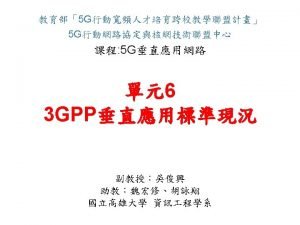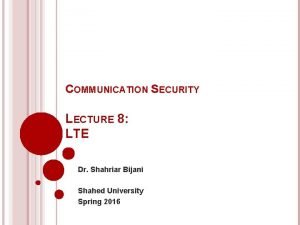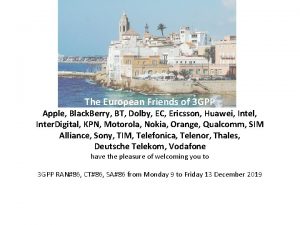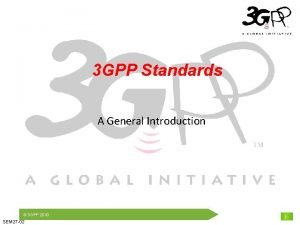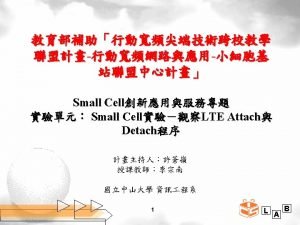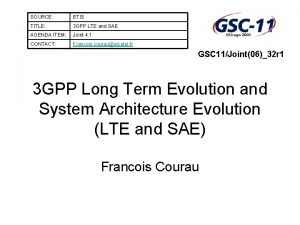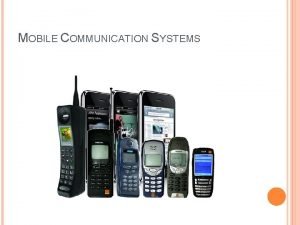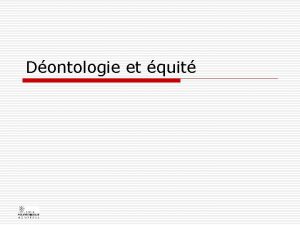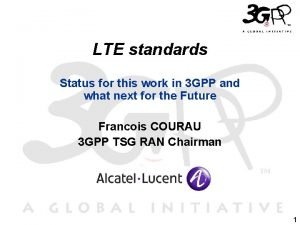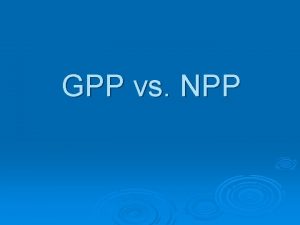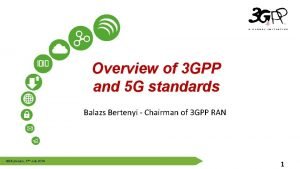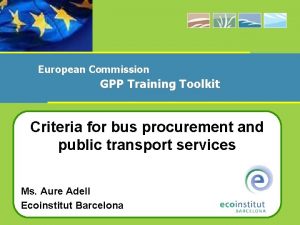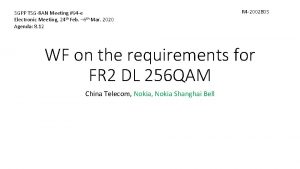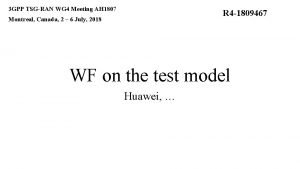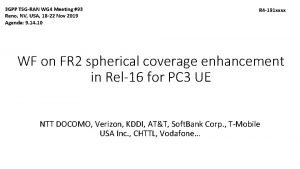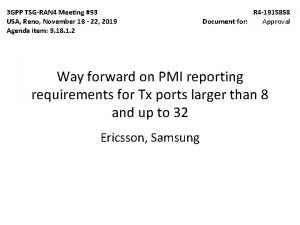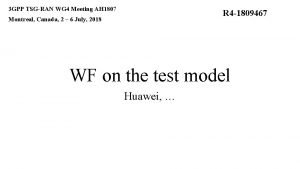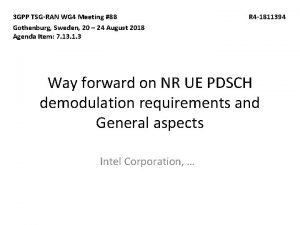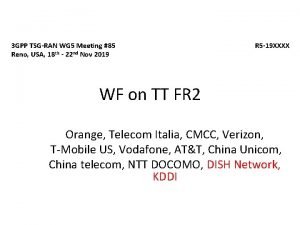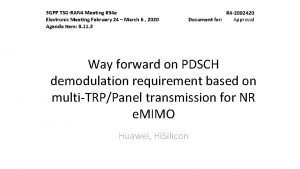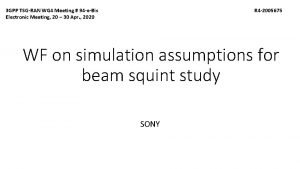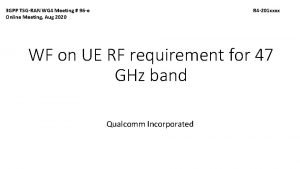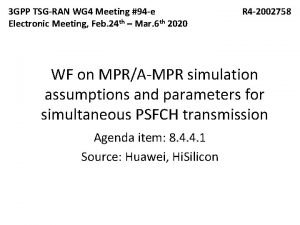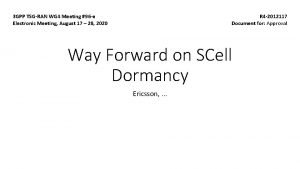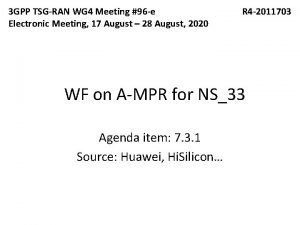3 GPP TSGRAN WG 4 Meeting 94 e



















- Slides: 19

3 GPP TSG-RAN WG 4 Meeting #94 -e Electronic Meeting, Feb. 24 th – Mar. 6 th 2020 Agenda Item: 8. 17. 2. 1 R 4 -200 xxxx WF on UE demodulation for NR HST CMCC

Background • The following WFs were approved: – R 4 -1910050 WF on demodulation for UE NR HST, RAN 4#92 – R 4 -1912808 Way forward on NR HST UE demodulation, RAN 4#92 BIS – R 4 -1915926 WF on UE demodulation for NR HST, RAN 4#93

HST-SFN • Maximum Doppler frequency – For TDD 30 KHz SCS, 500 km/h ØOption 1 (CMCC, Huawei, Intel, DOCOMO) : 1667 Hz ØOption 2 (Qualcomm, Samsung): 1500 Hz – For FDD 15 KHz SCS, 500 km/h ØOption 1 (CMCC, Qualcomm, DOCOMO, Samsung): 851 Hz ØOption 2 (Huawei, Intel, DOCOMO) : 870 Hz

HST-SFN • MCS (for Rank 2) – Option 1 (QC, CMCC, Intel, Huawei, Samsung): MCS 13 – Option 2 (DCM) : MCS 4 • Antenna configuration – Define requirements for both 2 x 2 and 2 x 4, and applicability rule will be considered (tentative agreements in 1 st round)

HST single tap • Maximum Doppler frequency – For 15 KHz SCS, 500 km/h ØOption 1 (CMCC, Qualcomm, DOCOMO, Ericsson, vivo) : 1250 Hz ØOption 2 (Intel, Huawei, Samsung) : 870 Hz • MCS ( for Rank 1) – MCS 17 (tentative agreements in 1 st round)

HST single tap • HST single tap requirements definition – Option A (Qualcomm, CMCC, Huawei, Ericsson, vivo, Samsung): Define requirements based on worst case, and whether to use single-shot or multi-shot depends on UE implement and should not be limited – Option B (Intel): Do not mandate the specific TRS processing for requirement definition and left it up to company decision. Provide HST RRM signaling during the demodulation test to inform UE about HST conditions. – Option C (DOCOMO): Introduce the multi-shot TRS-based requirements is baseline • No additional network assistance is introduced (tentative agreements in 1 st round)

Multi-path fading channel • MCS – Option 1 (Huawei, Qualcomm, Samsung): MCS 13 – Option 2 (Intel, Ericsson, Qualcomm, Samsung): MCS 17 – Option 3 (DOCOMO): MCS 4 and MCS 17 • Rank – Rank = 1 (tentative agreements in 1 st round) • Antenna configuration – Define requirements for both 2 x 2 and 2 x 4, and applicability rule will be considered (tentative agreements in 1 st round)

Multi-path fading channel • Scheduling in TDD special slot for multi-path fading – Option 1 (Qualcomm, Ericsson, Huawei, Intel): For PDSCH with TDD configuration, do not schedule data in the special slot in order to achieve maximum throughput. – Option 2 (Intel, CMCC): Also check the HST-SFN performance in special slot – Option 3 (Samsung): Align with normal PDSCH assumption in Rel-16. – Option 4 (DOCOMO): Further simulation is needed.

Transmission scheme • DPS transmission scheme 1 (including 1 a and 1 b) – It is feasible to test the transmission scheme 1 without CRI/L 1 -RSRP feedback (tentative agreements in 1 st round) – Whether to define new requirements and tests for DPS transmission scheme 1 • Option 1 (Qualcomm, Samsung, Ericsson): Do not consider Transmission schemes 1 a and 1 b for defining new requirements • Option 2 (Intel): Define demodulation requirements for DPS scheme 1 a, consider transmission scheme 1 b in a later stage of WI. • Option 3 (Huawei): Only define performance requirements for transmission scheme 1 b for DPS • Option 4 (CMCC): it is better to have requirements for transmission scheme 1. If companies share the similar view that the requirements of HST single tap can be reused for transmission scheme 1, may be no new requirements is needed, and we just need to say in the spec that the requirements of HST single tap are applied to transmission scheme 1. • Option 5 (Vivo): we can define requirements and test cases for both 1 a and 1 b for different UE capability Note: Details of transmission scheme 1 a, 1 b, 2 and 3 can be found in Annex

Transmission scheme • DPS transmission scheme 1 (including 1 a and 1 b) – Test setup of transmission scheme 1 • Option 1 (Ericsson, Samsung): Since the HST-SFN channel model changes the strongest path (TRP) according to the simulated UE position, TE knows the strongest path based on Ds. This means, for example, TE can transmit PDSCH from TRP#0 for distance from 0 m to 500 m, TRP#1 for distance from 500 m to 1500 m, TRP#2 for distance from 1500 m to 2500, etc. With this deterministic selection, it is possible to simulate the DPS without CRI/L 1 -RSRP feedback from UE. • Option 2 (Intel): For Scheme 1 a when only one active TCI state is configured TCI state switching is triggered by MAC CE. In this case test procedure may be as follows: 1. UE is configured with two different TCI states associated with two different RRHs 2. PDSCH associated with TCI #0 is transmitted during the slots from 0 to (n-1) + HARQ needed time + 3 ms + first TRS + TRS processing time 3. In slot n test equipment start triggering TCI state switching command by MAC CE scheduling 4. PDSCH associated with TCI #1 is transmitted in slots from n + HARQ needed time + 3 ms + first TRS + TRS processing time to N. Note: Details of transmission scheme 1 a, 1 b, 2 and 3 can be found in Annex

Transmission scheme • DPS transmission scheme 2 – Option 1 (Qualcomm, HW, Samsung): Discuss transmission scheme 2 in e. MIMO WI first, then discuss transmission scheme 2 in HST-SFN deployment scenario later in HST WI – Option 2 (Ericsson, vivo): Discuss transmission scheme 2 in e. MIMO WI (including HST-SFN deployment scenario) – Option 3 (CMCC, Intel): Discuss transmission scheme 2 with high speed scenario in NR HST WI, discuss transmission scheme 2 with non-high speed scenario in e. MIMO WI Note: Details of transmission scheme 1 a, 1 b, 2 and 3 can be found in Annex

Transmission scheme • Transmission scheme 3 – Option 1 (QC, CMCC, HW, Samsung, Ericsson, Vivo ): Transmission scheme 3 is not supported in Rel-16, no requirements are defined in Rel-16 HST WI. Companies can bring analysis on the performance benefits and feasibility – option 2 (Intel): • Transmission scheme 3 is not supported in Rel-16, no requirements are defined in Rel-16 HST WI • Some companies show that transmission schemes 3 provide performance benefits for HST scenario compare to JT Note: Details of transmission scheme 1 a, 1 b, 2 and 3 can be found in Annex

Target speed • For HST-SFN, – FFS on whether to introduce requirements for target speed of 350 km/h. • Option 1 (Qualcomm, Huawei, Intel, Samsung): Do not define requirements for target speed of 350 km/h • Option 2 (DOCOMO, CMCC): Introduce requirements for target speed of 350 km/h with higher MCS. • Option 3 (vivo): If significant performance gain can be achieved for 350 km/h compared to that of 500 km/h, we can add some test cases with a note indicating that it should be applied for 350 km/h.

Release independent • Option 1 (CMCC, DOCOMO): release independent for HST-SFN, HST single tap and multi-path fading • Option 2 (Qualcomm, Huawei, Intel, Samsung, Ericsson, vivo): not feasible for release independent for HST-SFN since signaling is introduced in Rel-16. • Option 3 (Qualcomm, Ericsson): release independent for multi-path fading

Applicability for different channel models • Do not test UE under HST single tap and HST multipath scenarios, if UE passes the requirements for HSTSFN? – Option 1: Yes (Qualcomm, Huawei, Samsung) – Option 2: No (Intel, Ericsson, DOCOMO)

Updated simulation assumption for HST-SFN Parameter Value FDD 15 KHz SCS TDD 30 KHz SCS Antenna configuration DMRS type Number of DMRS symbols DMRS 1+1+1 TDD pattern 7 D 1 S 2 U, S: 6 D 4 G 4 U MCS Propagation condition TRS periodicity PDSCH mapping Ds and Dmin Rank BW Maximum Doppler shift MCS 4; MCS 13; MCS 17 based on 64 QAM table HST-SFN 10 ms, 2 slot pattern Type A, Start symbol 2, Duration 12 Ds=700 m, Dmin=150 m Rank = 2 10 MHz 40 MHz ü Option 1: 870 Hz ü Option 1: 1500 Hz ü Option 2: 851 Hz ü Option 2: 1667 Hz SNR @70% of maximum throughput Testing metric 2× 2; 2× 4 type 1 Note: The other parameters are same as Rel-15

Updated simulation assumption for HST-single tap Parameter Antenna configuration DMRS type Number of DMRS symbols MCS TDD pattern Propagation condition TRS periodicity PDSCH mapping Ds and Dmin Rank BW Maximum Doppler shift Testing metric Value FDD 15 KHz SCS TDD 30 KHz SCS 1× 2; 1× 4 (baseline) 2 x 2; 2 x 4 type 1 DMRS 1+1+1 MCS 17 based on 64 QAM table 7 D 1 S 2 U, S: 6 D 4 G 4 U HST-single tap 10 ms, 2 slot pattern Type A, Start symbol 2, Duration 12 Ds= 300 m, Dmin=2 m Rank = 1 10 MHz 40 MHz üOption 1: 1250 Hz 1667 Hz üOption 2: 875 Hz SNR @70% of maximum throughput Note: The other parameters are same as Rel-15

Simulation assumption for multi-path fading channel Parameter Value FDD 15 KHz SCS TDD 30 KHz SCS Antenna configuration DMRS type Number of DMRS symbols 2× 2; 2× 4 type 1 DMRS 1+1+1 TDD pattern 7 D 1 S 2 U, S: 6 D 4 G 4 U MCS Propagation condition TRS periodicity PDSCH mapping Rank BW Maximum Doppler shift Testing metric MCS 4; MCS 13; MCS 17 based on 64 QAM table TDL-C 300 ns 10 ms, 2 slot pattern Type A, Start symbol 2, Duration 12 Rank = 1 10 MHz 40 MHz ü 600 Hz ü 1200 Hz SNR @70% of maximum throughput Note: The other parameters are same as Rel-15

Annex • Candidate transmission scheme to be further studied – Transmission scheme 1 - DPS: PDSCH is only transmitted from one TRP at one time • Transmission scheme 1 a: UE only needs to track 1 TCI state (detail can be found in R 4 -1911003) • Transmission scheme 1 b: UE needs to track more than 1 TCI states (detail can be found in R 4 -1911091) – Transmission scheme 2 - PDSCH is jointly transmitted from two or more adjacent TRPs scheduled by multi-DCI(detail can be found in R 41911091) – Transmission scheme 3 - Joint transmission + Distributed reference signal (detail can be found in R 4 -1911003) • joint transmission + Distributed TRS • joint transmission + Distributed DMRS
 Gpp e
Gpp e Gpp lte means
Gpp lte means Apple gpp
Apple gpp Gpp
Gpp Cara membuat gaji induk di aplikasi gpp 2020
Cara membuat gaji induk di aplikasi gpp 2020 Gpp network
Gpp network Gpp lte
Gpp lte Gpp network
Gpp network Dontologie
Dontologie Gpp lte meaning
Gpp lte meaning Npp vs gpp
Npp vs gpp Gpp standards
Gpp standards Gpp bus
Gpp bus Maksud outstanding gpp
Maksud outstanding gpp Gpp good pharmacy practice
Gpp good pharmacy practice What is meeting and types of meeting
What is meeting and types of meeting Types of meeting
Types of meeting Today meeting or today's meeting
Today meeting or today's meeting Meeting objective
Meeting objective Job meeting bari 2017
Job meeting bari 2017
